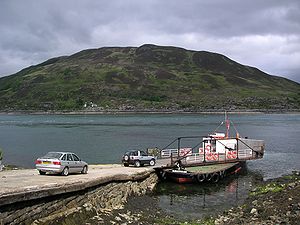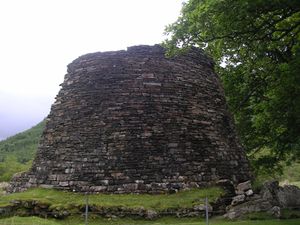Glenelg, Highland
| Glenelg | |
| Scottish Gaelic: Gleann Eilg | |
 Glenelg-Kylerhea ferry |
|
6px Glenelg shown within Scotland | |
| Population | 283 [1] |
|---|---|
| OS grid reference | |
| Council area | Highland |
| Country | Scotland |
| Sovereign state | United Kingdom |
| Post town | KYLE |
| Postcode district | IV40 |
| Dialling code | 01599 |
| EU Parliament | Scotland |
| List of places: UK • Scotland • | |
Glenelg (Scottish Gaelic: Gleann Eilg) is a village in Skye and Lochalsh, Highland Region, in western Scotland.
Geography
Glenelg is located by the Kyle Rhea narrows, where Skye is closest to the mainland. Road access is by the 339m Bealach (pass) Ratagain from Shiel Bridge, on the main Inverness to Skye road.
Its proximity to Skye meant that Glenelg was formerly of more strategic importance. Cattle reared on Skye were routinely made to swim to the mainland before being herded to market along the drovers' road to Kinlochhourn and on to the Lowlands.
Following the initial Jacobite risings, Glenelg was chosen as one of four sites in the Highlands for a military barracks. These were completed in 1725 and a military road soon linked Glenelg to the rest of General George Wade's road network. Ultimately unsuccessful in preventing the 1745 uprising, and not needed after the Highland Clearances, the Bernera Barracks are now ruined.
A person from Glenelg is known in Gaelic as an Eilgeach.
Ferry
Between March and October, a small vehicle ferry connects to Kyle Rhea on Skye, across the powerful currents of the narrows. The ferry used on the crossing since 1982 is the Glenachulish, the last turntable ferry in operation.[2] Built in 1969 for the Ballachulish crossing, by the Ailsa Shipbuilding Company in Troon, she is now operated by a local Community Interest Company. The ferry can transport six cars plus foot passengers on the open deck. Cars are turned on its unique hand-turned turntable. When the Ballachulish Bridge opened in 1975, she became the relief vessel for Corran, Kylesku and Kessock, near Inverness.[2]
Attractions
The ferry is a tourist attraction in itself. The former structure of the Sandaig lighthouse has now been erected on the slipway to serve as a souvenir shop.
Glenelg attracts tourists to the remains of two of the best-preserved brochs (Dun Telve and Dun Troddan) on mainland Scotland, but remains unspoilt.
Etymology
Glenelg is noteworthy for being a placename which is a palindrome. Although the name nowadays refers to the whole district, it is likely that it originally referred only to the glen containing the brochs. The specific element of the name (Eilg) is found elsewhere, such as in Elgin (Gaelic Eilginn) and is generally accepted as being a kenning for Ireland. Other such names include Banavie, Banff, Atholl, Lochearn, Auldearn, and show Gaelic settlers using the same migrant naming practice as gives us placenames such as New Caledonia, New York and so on.
Sandaig
The retreat of the author, Gavin Maxwell (known as Camusfeàrna in his books), is about six miles south west of Glenelg. The Sandaig Islands are a small group of islets just off the point in the Sound of Sleat.
References
- ↑ 2001 Census
- ↑ 2.0 2.1 "Glenelg Ferry". Gazetteer for Scotland. http://www.undiscoveredscotland.co.uk/skye/glenelgferry/. Retrieved 17 October 2009.
| |||||||||||||||||

